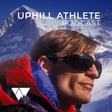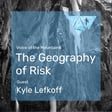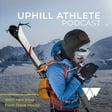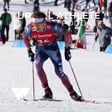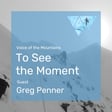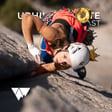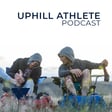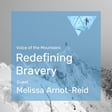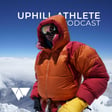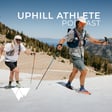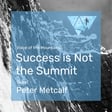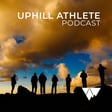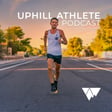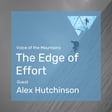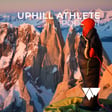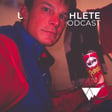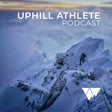Become a Creator today!Start creating today - Share your story with the world!
Start for free
00:00:00
00:00:01

Getting into SkiMo with Sam Naney, Scott Semple, and Luke Nelson
Coach Sam Naney is joined by athlete Luke Nelson and coach, and 2019 Canadian Masters National SkiMo Champion, Scott Semple for a chat about all things ski mountaineering. Sam, Luke, and Scott have a great collective history in skimo racing. Join them as they talk about skimo racing in the US and in Europe; ways to train for and get involved in skimo; dive into some particulars about the gear needed; and learn how to get out there and make the best of ski mountaineering and racing.
Transcript
Introduction to Uphill Athlete Podcast
00:00:01
Speaker
Welcome to the Uphill Athlete Podcast. These programs are just one of several free services we provide to disseminate information about training for mountain sports.
00:00:10
Speaker
If you like what you hear and want more, please check out our website, uphillathlete.com, where you'll find many articles and our extensive video library on all aspects of training for and accomplishing a variety of mountain goals. You'll also find our forum where you can ask questions of our experts and the community at large. Our email is coach at uphillathlete.com, and we'd love to hear from you.
Meet the Coaches: Sam Naney, Luke Nelson, and Scott Semple
00:00:36
Speaker
Hello, everybody, and welcome to the Uphill Athlete Podcast. My name is Sam Naney, and I'm an Uphill Athlete Coach. And I'm joined today by Luke Nelson and Scott Semple, both of whom have great history of careers in schema racing, as well as other mountain pursuits. And so today, our goal is to chat a little bit about schema racing in the US and in Europe, and then in particular,
00:01:04
Speaker
ways that you can train for it, ways that you can get involved in it, and also dive into some particulars about the gear that you need and really how to get out there and make the best of some ski mountaineering, adventuring, and racing.
What is Schema Racing?
00:01:20
Speaker
So to get started, I think we'll have you guys introduce yourselves. So maybe we'll start with you, Luke. Just introduce yourself, give a little background, and we'll get rolling.
00:01:31
Speaker
Sure thing. So my name is Luke Nelson. I am a professional endurance athlete. Most recently, my focus has been on trail running and mountain running. I do have quite the history with ski mountaineering racing or schema, as we call it here in the U.S. I have been on two U.S. teams, race both in the U.S., Canada, and in Europe. I won a national championship a few years ago and
00:02:01
Speaker
love getting rowdy in the mountains on Skimo gear.
Backgrounds: Luke Nelson and Scott Semple
00:02:05
Speaker
Nice. Semple, what about you? My name is Scott Semple. I'm a coach, also like Sam, a coach at uphill athlete. And I started messing around the mountains as a climber and did that for quite a few years and then started skimo racing in 2014. And I was on the Canadian team three times, I think.
00:02:32
Speaker
Yeah, it's training for schema really helped my endurance training knowledge. And I certainly don't have looks results. Unfortunately. But anyway, it was, it was, it's a lot of fun. It's a great sport. And yeah, it's, I look at that time and pray
Schema Racing's Growth in the US
00:02:52
Speaker
fondly. It was fun.
00:02:54
Speaker
So I think one of the things that'll be interesting to talk about with this sport, it's in a somewhat unique position in the US, particularly where it's very much still growing. There are probably people who are listening to this who maybe
00:03:11
Speaker
haven't heard of it at all or have only heard of it sporadically. And I think something to maybe to start with is to go a little bit more in detail about how each of you found your way into the sport. So there's a lot of different avenues for it. Maybe somebody might be involved in mountain running and then figure out that they can do something similar in the winter and have the benefit of being on skis going down.
00:03:35
Speaker
As you know, like with you simple you spending time in the mountains climbing and then realize you can do a lot of that fun on ski. So let's dive in a little bit deeper into how you how you found schema racing and what your background was particularly, you know, that may be benefited you transitioning into the sport.
Luke Nelson's Journey into Schema Racing
00:03:54
Speaker
Luke, why don't you jump on that? Sure. I mean, my history growing up actually grew up as a snowboarder. And
00:04:03
Speaker
when I was in during my undergrad degree I got an opportunity to do some guiding and just after I started with this company they asked if I could guide on skis and not on a snowboard which was my immediate introduction into learning a how to ski and b how to ski in the backcountry shortly thereafter
00:04:25
Speaker
through a series of interesting events. I found trail running as a sport. So I didn't do any of this growing up. I was just kind of a punk kid. But those same friends that introduced me to trail running are the wrong kind of people to hang around with because they also introduced me to schema racing.
00:04:43
Speaker
So just as I started off learning, uh, how to move in the mountains as a trail runner, I was learning how to, uh, back country ski and, and started with schema racing. That's been, you know, uh, she's 14 or 15 years ago
Gear Challenges in Schema Racing
00:04:57
Speaker
now. And at the time in the United States, the sport was really kind of finding a place. It was that there weren't very many races.
00:05:06
Speaker
equipment was very difficult to come by. I remember the first race that I tried to find a skimo suit, these one piece suits that are kind of purposely designed. It took me months of calling all the guys that I knew that had been doing it or had been previously to Europe or something begging to have their secondhand suit or something like that.
00:05:29
Speaker
So, but I did get hooked pretty quickly with finding this incredible efficiency of how quickly you can move up mountains and down mountains on this lightweight equipment and the racing aspect was just an extra motivator to keep progressing and moving faster and faster.
00:05:46
Speaker
Yeah, and so I think that's what we tend to see a lot is especially with mountain runners finding this avenue into schema. And one of the questions that I get a lot from a coaching standpoint, but I think also just in the community is,
00:06:06
Speaker
you know depending on the nature of the particular terrain that you're racing on you know getting up the hill allowing for you know some a fair bit of technique knowledge is one thing but but then descending often on on really technical you know back or near country terrain is another so you know how in terms of your transition there like did was that pretty were you able to pick that part up as well pretty quick with your snowboarding background and learning to ski or was
Scott Semple's Transition to Schema Racing
00:06:32
Speaker
that
00:06:32
Speaker
a whole new game going on 65 mil underfoot skis and ripping down on one piece. I think it would depend on who you asked. I certainly felt like I was proficient at descending very quickly, but it definitely wasn't pretty. I ski like a snowboarder, like I don't know what to do with my hands when I'm descending. And to this day, still do, even with, you know, millions of vertical feet skied.
00:07:03
Speaker
But I think that some of the just body mechanics of managing your body in space at speed or under dynamic changes transferred, but it wasn't easy. It took some work and some very kind of focused training on descending to develop the skiing to a point that I could descend on these little bitty skis at rates that downhill racers ski at, you know.
00:07:29
Speaker
Yeah, yeah, exactly. Semple, what about you?
Cultural Differences: European vs US Schema Racing
00:07:33
Speaker
You were focusing on getting up technical pitches of mountains. What drew you into doing the Skimo and more that endurance component? When I was climbing skiing, it was actually something I avoided. So until I took some courses, I was a super horrible skier. I'm from Saskatchewan and I've skied.
00:07:56
Speaker
you know, once a year since my team, but once a year isn't much. So I took a couple of adult racing courses. And that was a huge help in learning, learning to ski, learning how to use a ski and an edge and all that kind of thing. And then it's kind of in between or after climbing, wanted something more family friendly, because I had a family at that point.
00:08:20
Speaker
And endurance training is just easier to schedule, and ski mountaineering had always seemed appealing, or skimo racing had been appealing, and then they had taken this ski racing course, and I thought, well, we can maybe combine the two of learning how to be an endurance athlete and
00:08:41
Speaker
and do
Training Methods and Essential Gear
00:08:42
Speaker
some skiing. So I'm, in contrast to Luke, I'm a reluctant runner at best, even, I mean, I've done a lot of training for Schemo, but it's not a first law, that's for sure. So, but it's a necessity.
00:08:56
Speaker
And then, so you kind of, you feel like you, especially with the, with the specific gear, you kind of learn, learned on the fly. So going from maybe traditional alpine gear to schema racing skis and learning how to move well on them and particularly to send on domestic and then especially European courses, which is sort of a trial by fire.
00:09:19
Speaker
Yeah, well, I think any time you're on a ski, most skis are tiled by fire, even if you are a really good skier, because they're, like I say, 65 millimeters underfoot, 160 centimeters long is the men's length, women's skis 150, and they're really soft. So to go uphill, they're great. That's what they're designed for primarily. The higher end skis ski pretty well, but it's certainly
00:09:47
Speaker
You just don't have the support. And it's pretty close to survival skiing most of the time.
00:09:57
Speaker
Yeah, it's funny. I didn't grow up alpine skiing at all, but spent my life Nordic skiing. And I'll tell all my Nordic skiing friends, for the myriad reasons that they should get into Skimo, one of them is that the skis aren't terribly wider or bigger than a typical Nordic skate ski. And so if you're pretty good at descending on crappy snow and trails on the Nordic ski,
00:10:25
Speaker
then putting on Skimo skis feels like a great platform and stability. Yeah, they can get pretty squirrely, especially if you're used to big powder boards or GS type skis.
00:10:41
Speaker
So I think what would be kind of cool to talk about is, you know, again, we're banding around the term schema, you know, short for ski mountaineering. And I think the way that that schema racing evolved, the best of my understanding, you know, first in Europe, and then being brought over to the US,
00:11:02
Speaker
you know, truly was that it was scheme out nearing and in the most honest sense and in the Alps and Pyrenees and different areas of Europe. But it's it has started to take on this more specific race form where it, you know, really, you know, particularly in a lot of races in the US to exist solely in the bounds of an
Historical Roots of Schema Racing
00:11:24
Speaker
Alpine area. So maybe let's let's define it a bit and particularly define it for both the US and the European
00:11:32
Speaker
maybe throwing out some examples of races in either venue. And then we can go from there and chat a little bit about the race formats and then get into some training. So maybe one of you, Luke, I guess, why don't you talk a little bit about what would be a good example of a ski mo race in the US versus Europe and how that might differ from going out and ski touring.
00:11:58
Speaker
Sure. So, I mean, the biggest difference if you were just to compare it to going back country skiing is the pace, right? I mean, this is a race or generally a race format. And so you're moving very quickly. If we look at, you know, let's look at a classic race in the U.S. and we'll say the Wasatch powder tag.
00:12:17
Speaker
held in the Wasatch Mountains Salt Lake. The race over the years has had a few different venues currently held at the Brighton ski area. The race itself has, I believe, it's been a while since I raced that one, but I believe it's about 5,000 vertical feet of climbing.
00:12:37
Speaker
And that would involve multiple ascents and descents so that a transition you would skin uphill transition at the top descent down some Generally at that race some some slack country type terrain And then you would transition to go back uphill covering this the ground over a period of a couple of hours or less the the skiing
00:13:04
Speaker
is in areas that have primarily been skied. You're not skiing fresh powder, you're not skiing ideal conditions ever and
Evolution of Schema Gear
00:13:12
Speaker
often really challenging conditions because you're not going to ski down a groomed run, they're going to send you down whatever they can to make it challenging. Compared to Europe, the European races are much truer to a ski mountaineering format. They are often held
00:13:28
Speaker
in backcountry areas or what we would consider a backcountry area. They're not skied groomed runs that you're crossing or going around and often are far more technical. Some of the most technical skiing I've done in my life was in ski mountaineering races in Europe, which is
00:13:47
Speaker
definitely a contrast to the United States races. Overall, time-wise though, races end up being somewhere from that two to three hour range. There are a couple of different disciplines that we can get into in a minute, but the classic ski mountaineering race would be the individual race or a team's race, you and a partner of these longer mountain courses. Yeah, and one thing that I think
00:14:11
Speaker
is really neat in terms of the history of it. To my understanding is thinking about the early iterations of ski mountaineering racing in Europe was for the military, for military training, right? So the PDG, the Petrol de Glossier race was about this military training in that Alpine terrain for the format and building those skills. And now it has bloomed into this international event.
00:14:41
Speaker
But I presume there are other races like that in Europe and then in the US starting to see that similar, as you said, the team format. So something like the Grand Traverse being an example in Colorado where you're really moving through terrain, bringing some different skill sets to bear over a long period.
00:15:04
Speaker
Yeah, absolutely. And as the sport grows up in the US, I think that there have been races developed that include
Schema Racing vs Traditional Ski Touring
00:15:12
Speaker
more difficult terrain or more challenging terrain. But unfortunately, that the environment that we live in is a little bit litigious and for permits and insurance purposes, they end up within those key area boundaries often. Yeah, yeah, that makes sense.
00:15:28
Speaker
Another thing that's probably different, and just based on the history between North America and Europe, is in the races in North America, at least the ones I've been to are more grassroots, I guess, is the right term, when there'd be a mix of people on like
00:15:52
Speaker
just normal touring gear, and then a few of us weirdos were in the suits with the skinny skis. And then in Europe, it's very much, I don't know, more serious, I guess, or more, maybe serious is the wrong word, but it's like participation over here versus for a lot of people over there, it's a profession. So it's a definite organized sport that's a lot more formal. I guess more formal is maybe the word. So it's the,
00:16:22
Speaker
the vibe is different. And I think that just comes from the age or the experience of the countries because in North America, it's a lot newer versus in Europe, they've been having these things for a long time. Yeah, I know. Go ahead, Luke. I think that there's a culture difference too. You see in Europe, you see just a lot more of a culture of people using this very lightweight
00:16:50
Speaker
type equipment for their ski tours and
Improving Racing Performance
00:16:53
Speaker
and in North America or in particular in the West where I live like you get scoffed at if your skis are under 120 underfoot you know like so we're skiing on it's you know there's little bit of gear but in Europe it tends to be generally just culturally more the norm of
00:17:10
Speaker
to have that a tight-fitting, lycra-type pant and really light gear. And you might see 65, 70-year-old women out there crushing it, doing their morning training or whatever.
00:17:26
Speaker
Well, and that's, I think that that's a really interesting thing that, you know, certainly, you know, partially compelled this, you know, this idea of doing this, this having this conversation and others and recognizing that schema is really on the rise in the US, because as you point out, both of you
00:17:43
Speaker
you know you you show up to a standard ski mountaineering race in the US and and we my wife Alice and I we host a little one here in the Pacific Northwest as sort of truly a beginner get to know the sport sort of thing and
00:17:58
Speaker
Yeah, you have a handful of people at the front who have race specific gear and they're in skin suits. But the vast majority of people are on now a wide array of touring gear. And it seems like that's where we're really going to see a lot of evolution and changes. People start to realize that the lighter gear can lead to
00:18:23
Speaker
you know, better ways to train for it, right? So if you're, if you've got, you know, a 110 underfoot powder ski, and that, you know, so when you're going out and touring, you're moving it at a rate that you're allowed to with that, you know, heavier and larger gear. When you put on, I remember the first time I put on a pair of Skimo skis, it was just like,
00:18:46
Speaker
Whoa. It really does feel akin to that. You talked about, Luke, this transition from mountain running. You realize how quickly you can move up a Skinner on those skis and with lightweight, highly articulating boots. So I think that's something that as people delve more into it and get excited about and have opportunities to try the gear,
Technical Skills in Schema Racing
00:19:14
Speaker
that will then lead not only to more people getting involved in the sport, hopefully, but also sort of a heightening of the level, akin to what you're saying, Semple, because when you can train on that sort of gear, your ability and your fitness and strength for the sport grows so fast because suddenly the cadence that you can train at and the amount of vert that you can accomplish really elevates.
00:19:42
Speaker
Yeah, for sure. And it's maybe a little counterintuitive because I could see someone thinking, well, if I use heavier gear, I'll get fitter. But that's not how it works. The Canadian system is different. The muscle recruitment is different. And basically, the lighter your gear, the faster you can go and the better you can train for it.
00:20:01
Speaker
I think my biggest ski is 98. And to be honest, I hate using it. I just don't use them anymore. Because it's just not fun. It's just too heavy. And it's true what you said, Luke. I'm out here in the Pacific Northwest, up in the North Cascades, whiskey powder. In the springtime, we get touring conditions where it's corn. You can move really fast on top of the snow.
00:20:28
Speaker
And that's when I love pulling out, you know, my either my skimo skis or something that's under 80 under foot, but, you know, mid winter, uh, you know, I'm not going to be so inclined to take my skimo skis out because we've got, you know, a foot and a half of new powder and they don't, they don't, they just don't ski the same. So I think, I think that's an interesting, you know, certainly when you look at, uh, the evolution of the sport in the U S it really sort of the,
00:20:55
Speaker
The ground zero for the growth of it seems to be in the Colorado region where you don't necessarily have these back to back to back deep powder snowfalls, but you have the opportunity to move fast on the skinnier gear. Yeah, definitely. I've seen that. Oh, go ahead. Go ahead. No, go ahead, Luke. That's fine.
00:21:17
Speaker
I was thinking of when I was training a lot for this, the looks that I would get on a powder day or maybe a day or two after a powder day in a local backcountry zone, we've got a spot that a lot of people ski and it's like an 800 foot run or so and it shares a skin track on kind of a wide slope and so you ski down and then everybody takes the same skin track up and I would be
00:21:41
Speaker
on my third or fourth or fifth lap, skiing that, lapping people who are still on their singular lap with their big gear, they'd slog it up and it was short enough and the gear was light enough, I'd just zip and pass them and they're like, well, how was it any fun to ski on those little skis that they'd always ask her? And I'd say, well, I get a lot more face shots and I got a lot more skiing than you. I get to go deeper because that's sitting on top of it. Exactly.
00:22:09
Speaker
Yeah, what about you, Semple? So you were doing your training up in Canmore. Was that an issue for you of facing a powder day with 65 underfoot? Or did you have conditions pretty conducive to this?
Training Methodologies for Efficiency
00:22:24
Speaker
Well, no, the snow packing in the Rockies is pretty thin at the best of times. I think if you're a hardcore skier, you should move out west in your neighborhood.
00:22:35
Speaker
Because it's shallow. It's really cold. I mean, for training, most of the time, I would do in and around ski hills or nearby. And then for touring days, yeah, like I said, I wouldn't take my race stuff because I'd be worried about brake. But I wouldn't take stuff much heavier. So kind of entry-level race stuff or maybe a little wider.
00:23:03
Speaker
Yeah, so we don't get huge. It's rare to have a lot of powder in the Eastern Rockies.
00:23:11
Speaker
Yeah, so this seems like kind of a good transition maybe to talk a bit about some training methodologies, certainly for really I think anybody's level in this sport or transitioning into this sport. So when we think about, again, ski touring or ski mountaineering in a true back country sense, out exploring versus the racing format,
00:23:38
Speaker
maybe talk about some strategies how people who are doing that more the more the former of touring to start shifting some of their available time on skis to schema specific. So what would be you know how do we define the ratio of you know spending time on wider powder boards which
00:23:59
Speaker
Again, you can get an aerobic effect, obviously. You can up or down regulate your effort accordingly to get your heart rate into a correct training zone. But what are the things that really contribute well to performing in schema to help make that transition?
00:24:20
Speaker
It's got kind of hit a concept, a really important one, at least from the training aspect a moment ago when he mentioned the cadence. During the time when I was racing really seriously, I spent little to no time on non race sized gear. I would also not be on my like lightest race, race setup.
00:24:40
Speaker
for a lot of training, but something about the same size, maybe built a little bit heavier, but overall using that equipment. And one really important thing kind of distinguished between training in a touring or a backcountry area versus maybe at a ski area is the skin track. If you're out there breaking trail all day, you're not moving efficiently enough to get the maximum training that you need for a ski-mo race.
00:25:08
Speaker
because it's just much more of a strength dependent instead of that top end aerobic effort that you would need for a race. So important, I would say that if you are only having access to a touring or a backcountry area is to set a skin track and use that same skin track over and over again.
00:25:30
Speaker
and hopefully maybe in some days you do have access to a ski area where there's you know either either groomed runs or something like that you can skin on. Yeah I would agree and I think it comes down to the distinction between are you training or are you uh recreating and you know it's common distinction in climbing like climbers like to climb a lot and they call it training but it's
00:25:59
Speaker
If you're structured training, then you're training for a sport. And as Luke said, you have to make it specific. So you want to use the equipment. You want to use the same terrain. And if you're grinding uphill with heavy gear and deep snow, that's not a female race. It's too slow. It's too heavy. It's not going to make you fast. It might make your legs strong, but it won't make you fast as far as taking off vertical meters. So you need to do this specific training.
00:26:26
Speaker
Yeah, another thing that I noticed on my, I guess my first female race was the Grand Traverse, but then doing the first sort of short, you know, individual event a couple hour long, I was amazed at the steepness of the skin track. And, you know, because I was used to ski touring in the back country and growing up learning how to ski tour, I was mentored by mountain guides.
00:26:55
Speaker
And they in turn had developed their strategy of setting a skin track in a very sustainable manner, you know, right? The one that can be followed by their clients well and one that's going to, you know, stay in place on terrain.
00:27:10
Speaker
no matter how many people go through it and blast out a kick turn or something. So they tend to be more gradual and a little bit more undulating through the terrain. And when I did a first schema, I was like, wait, wait, we're just going straight up like that? It was really remarkable how much steeper it was. So I think that, thinking about specificity, that's another piece that is easy to miss if you're
00:27:34
Speaker
you know, training on your own, maybe, you know, trying to set a track, to really think about the fact that in a, in a schema race, and it'd be great to hear your guys's thoughts on this and experience, like it, what I've noticed is that, that, that's the up track tends to be pretty steep and really focused on, on getting the vert as quickly as possible. And, and that brings in this whole host of
00:27:57
Speaker
technical proficiency in terms of being on the gear well, managing skins, uh, you know, not blowing out your kit, keeping the tempo high. So what, what are your guys thoughts on that? I think it depends who set the track. The steepest races I've been in were set by people with like a hundred mil skis with their, with their heel riser on the max. And I don't, and, and that, you know, they're not ski more races and it's non-efficient track. And I don't,
00:28:27
Speaker
think the vertical climb rate is the fastest. Typically, the fastest, I think, is between 12 and 14 degrees, which is about 20 to 25%. But if you have really wide skis, really wide skins, and put your riser on the max setting, go a lot steeper. And it feels harder, so people think, oh, it must be faster. But you look over on the piece that a guy in a ski motor race, and he'll win every time.
00:28:57
Speaker
Because it's just being efficient is more important than trying hard. So if you're efficient and try hard, then you climb at a loose rate.
00:29:09
Speaker
I would say that there's a difference between the U.S. and Europe in that case as well. The U.S. courses that I've raced tended to be far steeper, partly maybe because of the inexperience of the setters or the inexperience of the race itself, but in Europe they tend to hit that sweet spot a lot more often so that there was less of that steep drag race kind of stuff and more of the efficient
00:29:34
Speaker
I think you're right with that incline that the 12-14% is kind of that magic for efficiency for maximum meters. Yeah. Well, and that makes sense too. When you watch really strong, particularly European schema racers, and you see it perhaps a side profile of them skinning, they have a technique that's very reminiscent of Nordic classic skiing.
00:30:04
Speaker
right so they're driving that there they're getting good hip extension up on a ski and granted you don't you don't achieve the glide that that a Nordic ski can but you have a lot more friction but but there's still a glide component I mean it's not you're not simply running on skis right so there's
00:30:21
Speaker
There's a technical component there that, again, is different from ski tour big powder boards. So how did each of you sort of come to achieve that? Were you watching other racers? Were you sort of experimenting on your own? How did you sort of adapt your personal technique to get that more efficient glide and movement on the ski-motor race gear?
00:30:49
Speaker
I'd say for me it came, I got through my first big season of races in the US and went to a European race and one of the Canadian coaches pulled me aside during a warm up day. Jeff, I can't remember his last name, Colvin maybe, pulled me aside and said, hey man, you got to quit running on your ski gear and start skiing.
00:31:13
Speaker
And he took 10 minutes or 15 minutes and showed me just how to stride with it a little bit better. And even though I'd not been training specifically that way, that little shift in efficiency made just a tremendous difference for me in the races that I raced that trip to Europe, as well as following in the years that came afterwards. So it was trial by fire somewhat there for me.
00:31:41
Speaker
Similar for me too, trial by fire kind of recommended and then self-inflicted. Scott Johnston, the founder of Upla Athlete and the Sams and my friend and mentor, said to me, you need to learn how to glide a ski. He hadn't seen me ski, but he knew I was a climber, so he guessed correctly that I needed to learn. And so he said, go get some classic skis and learn how to glide a ski across a cross-country ski.
00:32:11
Speaker
And, uh, from there, I got a pair of roller skis, which is a real trial, trial by
Off-season Training for Schema Racing
00:32:17
Speaker
fire. Um, and it, and so I'm not, I'm not a good classics here. Um, like for Sam, it's, if you and I went out town, I'm sure wouldn't, wouldn't even qualify as a workout, but it helped me be stable on a ski most ski and just to get a little bit more glide out of the skins. And then. You know, there's just, it's just more efficient.
00:32:39
Speaker
So that was how I tried to do it. Yeah. Yeah. And I think, I mean, we've, you know, when I've talked to athletes about, you know, getting involved in ski moments and certainly people who have a very, uh, you know, who want to take a focused approach to becoming a competitor in races.
00:32:56
Speaker
then I'll really encourage them to get on some roller skis. But granted, you know, roller skiing is a unique sport unto its own in some respects and brings dangers not insignificant. So I guess if you were, you know, for folks who maybe want to split that difference and figure out how to get a little bit more of the technique component and maybe we'll subtly shift gears here and think about, you know, our current
00:33:26
Speaker
We're sitting in mid-fall right now. Nobody that I know of is fortunate enough to be skinning yet. So what are some ways in which, in your guys' experience, people can start practicing some of these techniques, different dryland drills or movement patterning that they can be doing now to contribute to eventually getting on some schema gear?
00:33:50
Speaker
I would throw a comment out there about roller skis. They actually were a part of my training pretty seriously the last few years that I was very focused on racing. And I took it and all the Nordic skiers that listen to this are going to cringe, but I mounted a Tekto on a roller ski with a little bit larger wheel. And then I would just
00:34:15
Speaker
urban schema all over the town that I lived in um super early in the morning because cars are dangerous but uh you know I'd put in an hour and a half a day five or six days a week on the
00:34:29
Speaker
roller skis with my skimo boots and and tech toes on them cruising up and down the hills and in town and i think that that was i mean that's as close as you can get without being on snow and that was was gave me a leg up on those early season races but i think there are a lot of other things that you can be doing aside from that if you don't have access to that equipment that that can get you ready yeah i would agree one thing
00:34:59
Speaker
uh with roller skis that I would do is go to the steepest hill in town with my truck and three bikes and uh you know so for I gotta I had to figure out so I wouldn't leave anything behind so I drop all the bikes at the top drive to the bottom ski up bike down ski up bike down ski up bike down um and when you're on an eight-year-old 16-inch
00:35:25
Speaker
bike, it can be an adventure getting down. Um, but anyway, that, that was helpful because flat, like flat roller skiing, um, will definitely help glide. But I think it's important to get some, put some hills into it too. And roller skis are too terrifying for me to go down any significant hill. So that's why I use the bikes. Um, one, another thing I think that it's worth mentioning is that, um,
00:35:54
Speaker
It seems to me there's multiple movement patterns in schema and it could, it could, it's probably the same in trail running, mountain running. There's like low angle skinning where you want some glide, but then you hit an angle where it's too fatiguing to try and glide because you're trying to glide. It's too, too steep. And then you have to change to more above.
00:36:19
Speaker
high cadence hike, I guess, but you still wear your skis to slide. You don't want to lift your skis out the ground, but it's different than a classic stride. I don't know if I'm, I don't know, what, Luke, would you, what do you think? Well, I totally agree. Yeah, I totally agree. I mean, that lower angle is a, is a, it's not as quick of a cadence and it's a longer motion with what you're doing with your legs and then it gets steeper and it becomes almost more of a top step has come at how I would describe it where
00:36:49
Speaker
where you're sliding, but you're not trying to push out and get that maximum extension as you're going. And those different muscle groups, I think that there are some, I guess it would be bounding is what I would call it. I think Scott might have a different term for it, but where you're kind of doing these long, slow cadence, long kind of jumping motions uphill without the roller skis, you can do that just on any steep hill that can be
00:37:18
Speaker
somewhat of a mimic for that to help repair the legs in a training aspect prior to snow. Yeah, we use, I think it originated in Norway to be called moose hoofing. You have this trifecta of different ski imitation movements. You've got ski walking.
00:37:40
Speaker
which you get some ski poles that maybe are about as tall as your elbow, and you walk. But with the walking stride is a little bit more heel forward, so you're reaching the foot a little bit to mimic driving the ski, and then you match cadence of arms and legs. And then Musa thing I think maybe is what you're talking about, Luke, where
00:38:04
Speaker
you get this little bit of impulse off of each foot. So you're not exploding off the foot in a higher intensity bound, but it's a little bit of pop. So the time that you spend in the air
00:38:19
Speaker
is meant to simulate what you'd hopefully be doing by getting a little bit of glide on a ski. And yeah, that idea of a traditional Nordic classic stride is going to be about driving that foot really far forward and kind of grabbing the ground with your heel, setting the ski and then pulling your hips up onto it.
00:38:42
Speaker
on steeper terrain and sort of for efficiency on schema gear, it's harder to drive that foot so far forward. So it seems, yeah, like what you're talking about with this undulation of cadence and technique that that heel that's driven forward is maybe coming closer to midline of the body as you get more into that higher cadence or steeper terrain, but it's still, the emphasis is still driving the foot a little bit forward and bringing your hips up onto it versus
00:39:12
Speaker
in, in running where, where you're really focusing on, you know, driving the foot, driving the foot back, pushing, pushing off with that big toe and everything's happening behind you. How about that sounds completely accurate there for sure. Um, so yeah, go ahead. So it's also a way to tax and train different systems because if you lose, if you use a low cadence high effort
00:39:38
Speaker
uh movement pattern it'll be more muscular and then if you use something that's higher cadence shorter stride length it can be more cardiovascular so I think it's important to kind of mix those up because the terrain in a race might dictate one or the other and it'll be good to have trained both prior to to the event I think.
Building Aerobic Base and Intensity Training
00:40:01
Speaker
Yeah, and that is just a slap bang transition there, Semple, because I thought it would be good to chat a little bit about some specific training ideas. So we're talking about how
00:40:14
Speaker
Technique is obviously a big component of getting involved in, in schema racing, figuring out how to use the skis and how to move efficiently. So, um, you know, obviously it's an endurance sports. So the backbone of it is going to be building that good aerobic capacity. But as an event that, you know, unlike an, well, at least the typical schema race, uh, is going to be a lot shorter than say, you know, going out and doing a 50 K mountain run.
00:40:43
Speaker
So we have these different intensity zones that we need to target and we need to target them using this technique or simulation of the technique as best as possible. So maybe what I think would be interesting to hear is like for each of you, what were like one or two of sort of the clincher workouts or modes that you would use to really start trending toward getting your schema system on point maybe this time of year in the fall?
00:41:14
Speaker
Scott, you want to start that one? Sure. I don't know if I can say a certain workout, which is probably a big disappointment because everyone wants a top 10 list or something. I just found that season after season, kind of the more base training I could put in, the more high intensity training I could tolerate, and the more high intensity I could tolerate, the better I'd perform.
00:41:44
Speaker
And then on the opposite side of the coin, if my base hours dropped, my performance would suffer. So I can't, I wouldn't say a specific workout because it depends on the
00:41:57
Speaker
event. I think all events probably benefit from a big having a big base because then when you get closer to the event a couple months out you can start shaping it whether that's a 30-minute vertical that's a goal event or an all-day six-hour long long race.
00:42:17
Speaker
Well, simple one thing. I'm curious for you to give a little bit of a snapshot into what I certainly perceive to be a
00:42:29
Speaker
a real kind of clincher workout, which is one that, you know, you adapted from some ideas that Scott Johnston had used with some of us when he was coaching us for Nordic. And then you took it and sort of configured it for schema. And, and then I piggybacked on your idea last year and used it and I felt like it was really great. So maybe, you know, if you, if you're willing to, to give a little bit of insight into the treadmill workout that, that you used a couple of years ago when you were training for, um, for world championships.
00:43:00
Speaker
Yeah, sure. So like you mentioned, treadmill training. So in that season, I did all of my intensity on a treadmill because I wanted to do it by pace, not by effort or heart rate. Well, heart rate at high intensity is useless anyway. And in my opinion, perceived exertion is unreliable. So anyway, I wanted to be really specific. So I had all my high intensity on a treadmill. So the workout that Sam's talking about is
00:43:30
Speaker
I don't know, probably one of the most heinous that was in the program. And what it is, is about, I'm just trying to do some, convert some percentages. Like if you would go between five and eight percent over anaerobic threshold and then recover at anaerobic threshold. And then so the work interval is, starts out at like,
00:44:01
Speaker
two or three minutes, depending on the event you're training for, and the rest interval will, or no, sorry, the work interval starts more at one minute, and the rest, not rest, recovery interval at anaerobic threshold is about two or three. And then gradually, over months, like you're doing that workout maybe once every seven to 10 days, seven would be pretty frequent. The work interval gets longer, and the rest interval gets shorter.
00:44:31
Speaker
And the benefit that I found was primarily for the sprint event in schema. And for anyone that's unfamiliar, the sprint event in schema was around four minutes, maybe between three and five minutes. But the rough average would be a four-minute event where you're doing your skin, your transition, your boot pack, your transition, your skin, and then you ski down. So it's a super short course to do it that fast. And so in four minutes, you're going
00:45:01
Speaker
really hard. And so this this workout bouncing between harder than anaerobic threshold and recovering, quote unquote, or quote unquote, recovering and anaerobic threshold, it really increased my tolerance for that high pace. And from what I understand from the theory is that it probably improved my my lactate shuttle, which is just the ability of
00:45:29
Speaker
your aerobic system to reabsorb the lactate that the byproduct of the high intensity fueling glycolysis and use that lactate for fuel. And when it can use it for fuel, it keeps the lactate lower in the blood. And then so if lactate is lower, you're not going to have those burning muscles as intensely or as soon or as long. So it just
00:45:57
Speaker
It increases the amount of time you can tolerate that real high intensity pace. And it's the kind of workout that would make me nervous beforehand. Like, oh my God, can I get through it? Can I do it? So that, yeah, it was, I wouldn't, I wouldn't recommend that for a real long event. But, you know, feel free to disagree, you guys. But for a sprint event, it was very, very helpful.
00:46:25
Speaker
I, yeah, I, I mean, I used it. So I, I, Scott Johnston put me through and other skiers like me, you put it, put us through a format really similar to that on, on roller skis when you're training for Nordic. And then again, like you, you had described that workout to me a year or two ago. And so I gave it a go last year. And the thing that I found that is so beneficial from it, and I felt this with, with the Nordic skiing too, is
00:46:55
Speaker
is not only the physiological effect that you're talking about of improving this lactate shuttle and your ability to move well at the
00:47:06
Speaker
you know, anaerobic threshold or lactate steady state. But just an economy of movement, you know, the first time I did that workout on a treadmill, I found my movement breaking down, like almost falling off the back of the treadmill, just could not keep my legs moving. And we have a, Scott has a concept to ski ergometers. So we can basically simulate polling at the same time and just everything was kind of falling apart.
00:47:32
Speaker
And then after a handful of sessions, I found that even when I was tired, I could keep the movement pretty controlled. And and I think that developing that economy is sort of the underpinning to
00:47:45
Speaker
intensity training, right? Whether it's running or skiing or cycling or any swimming is, even when you're tired, you're moving well and efficiently. So that, I think, you know, using it for a shorter distance event, like the sprints, as you're saying, or even for something longer, you know, if you can, you can, you can tweak the, the variables a little bit, but that benefit of getting economy out of it is, it seems so, so crucial.
00:48:22
Speaker
Another thing reminds me of that in and around that work, I followed kind of a reverse.
00:48:33
Speaker
What's reverse periodization? That's not the right word, reverse. But rather than start with easy and get harder and harder and harder toward the event, I use both easy and really hard at the beginning, but not much really hard, trainy bit. And then as you get closer to your goal event, doing more hard sessions, but at a slightly slower pace.
00:49:01
Speaker
So you approach race pace for both sides. So that improves economy the way you've described. Another benefit that I didn't expect is the mental benefit is as you get closer to your goal race pace, you're thinking, yeah, this is painful, but I've endured way worse. So you have that mental comfort level with that race pace. Whereas if you come at it from a pyramidal
00:49:28
Speaker
point of view where things are getting harder and harder, then race pace could be pretty stressful, because it's the hardest thing you've done. So coming at it from both sides was really helpful.
Importance of Transitions in Schema Racing
00:49:39
Speaker
Yeah, yeah, absolutely. Luke, what about you? What are some clutch training ideas that you use that worked really well? Yeah, so my primary focus were the longer races, the individual or the team's race. I did my very best to stay away from the sprint race.
00:49:57
Speaker
because I don't like the taste of pennies in my mouth. And so one of my staples that would just get always at least once a week, if not multiple times a week, was to try to do a 10,000 foot day. So just a lot of volume. It wouldn't be at a particularly hard pace, keeping well within kind of aerobic threshold.
00:50:22
Speaker
but doing the time those would be between four and a half or six and a half hours depending on the train I was doing it in.
00:50:31
Speaker
And during those long kind of steady state efforts, making sure that I was paying close attention to my transitions were being efficient and that the descents were continuous. One of the things that I've seen people do in that type of a workout is they would, on the ski down, they would stop and look around and then ski a little bit and then stop and look around.
00:50:56
Speaker
the continuous motion machine there of a several hour long workout of consistent uphill, good transition, nonstop downhills, simulating more of a race effort. And it wouldn't be quite at race pace. It would be slightly slower and for longer period of time. To me, that was a stable workout that was in about every week.
00:51:21
Speaker
or which would kind of the block that I would break things into. Early season a couple of things that I would make sure that I would do leading up to the season. Often I didn't have immediate access to snow enough to ski but there would be enough snow to kind of scoot around on and so I would set up cones in a pattern of four and do transition drills.
00:51:43
Speaker
And I would start with my skis and skins on, I would take two steps, I would transition to downhill mode, I would shuffle two steps, I would transition to uphill mode, I would transition to on my pack, and then I would repeat the process over and over again, sometimes doing between 30 and 50 transitions in a session.
00:52:06
Speaker
the little pieces with schema or the things that make or break a race. And, you know, if you're talking about finishing between, you know, a minute and two minutes apart, that's one blown transition and you lost a place in the race. So I saw that as a really important part of the training that often gets overlooked because we're often focused on up or down, primarily up, but those transitions being a real key aspect.
00:52:35
Speaker
I totally agree. Luke brought up a bunch of good points there that I'd like to emphasize. The continuous motion machine, that's an awesome phrase. Because in a race, you're definitely not stopping. So just like Luke said, you've got to train the way you're going to race. And just to emphasize that, I totally agree that transitions get overlooked. And when your transitions are dialed,
00:53:01
Speaker
They're not a big part of the race. But if you screw one up, like you say, you lose to your nemesis by two minutes, that sucks. So there's no reason not to have awesome transitions. You don't need talent to have awesome transitions. You need to practice.
00:53:19
Speaker
It's like free, free speed. It's free. And, and transitions are great recovery workouts. Like, you know, you got 45 minutes just to get the, move the blood around. Just go to some hill that's like five meters high and do like Luke said, 50 transition. And you know, you, you skin up and you switch over your boot pack for 10 feet, then you switch back to skinning, then you get to the top, you do two turns and you start over again. And anyway, it,
00:53:48
Speaker
It, uh, it makes, it makes a difference. Then there's nothing more rewarding than coming into a transition last and leaving it before everyone else that was there already. Yeah. Those, those seem like, you know, especially, I think Luke that that is, that's a, that's a really good point because especially if you are coming from a ski touring background and wanting to get into schema.
00:54:16
Speaker
Like, you know, having the, having the focus, I mean, it's, it's a, it's a technical, it's a, it's a mental piece. And it's also physical to in your training sessions emphasize the continuous descent, you know, so you're, you're intentional with your top transition.
00:54:31
Speaker
And then the continuous descent and learning how to be on your skis so that you can be descending the whole time. And I'd be interested to hear your guys' thoughts on this, because I'm certainly, I don't have a background in alpine skiing to any great extent before I started skiing the backcountry. But as I think you said early on, Luke, you're not necessarily skiing pretty. You're descending. You're getting down. And the skis are small.
00:55:00
Speaker
and the snow is variable and chunky and often often all chopped up from because it's on an alpine area so you know getting it's it's just staying on your feet and moving through that and then yeah you get to the bottom and you have to have a system right so it's so in thinking about uh you know the transition system and and this this seems like it'll it would make a really worthy uh and i know there there are plenty of videos out there but maybe creating a worthy little video series of of transition tips but uh
00:55:30
Speaker
Do you guys have any mnemonic or something that you use when, especially when you're tired to just help you move through that transition of like, okay, I got to flip my boot lever and I've got to flip the heel rise and everything else. What do you think about, what goes through your heads when you're in that transition space and trying to move quickly?
00:55:52
Speaker
Mine was always boots binding skins that and I would just say that I'd say boots binding skin. So I'd unlatch my boots. I'd flip my heel piece and then I deal with my skins and it would be the same thing on up or downhill transitions. So, if I was going to transition to uphill, I've just descended, I would reach down, I would.
00:56:17
Speaker
unlock the boots, I would clip into my binding, or put my skin on and then my binding, but it's boot binding skin, boot binding skin. Yeah, same, same. Definitely, yeah, boots binding skins. And another thing I would say is you want, you always want
00:56:38
Speaker
You don't want a hand just floating in space. Two hands should be doing two things at all times. You can be flipping your right binding while grabbing the front of your left skin, and you want to practice doing those things synchronized so that you have overlapping tasks.
00:57:00
Speaker
Um, another thing, like if, if, if any listeners are unfamiliar with schema, just to give some numbers to transitions, like a world-class top transition where you're ski changing from skinning to skiing would take maybe 20 seconds. So that's a good, like super duper gold standard to shoot for. So I would say like.
00:57:25
Speaker
you know, first shoot, try and do it in a minute, then try and do it 40 seconds and try and get in 20. For the bottom transition going from skiing to skinning, that takes longer. Um, but I don't know, maybe try for one 15, 45, and then 30, something like that. Like those, those are on the fast side, those are what the pros are doing. So it's, it's, it's not minutes. That's for sure. And it takes practice to get there.
Gear Considerations for Newcomers
00:57:50
Speaker
Well, Scott, you mentioned this before. That's, that, that's not,
00:57:54
Speaker
because they're a talented person it's because they've practiced right those those fastest pros have just done them enough time they're automatic they're in order every time there's not fumbling about what goes next and and it's totally reasonable to have both of those under 30 seconds absolutely absolutely and yeah it is not a channel thing it's something you can practice and everybody can do i mean unless you have some kind of mechanical limitations but
00:58:19
Speaker
you know like VO2 max you're stuck with but your transition times you get to choose so you might as well make them fast. Absolutely. Yeah so kind of segueing a little bit since we're talking about gear to some extent maybe we can maybe we can finish up and offer you know some some suggestions and they can be they can be specific models or they can be sort of general guidelines but you know for the
00:58:46
Speaker
for the avid ski tour or the mountain runner who's looking to get into this sport, what are your guys' thoughts on gear? What should they be looking for? Should they go for the full Monte top end, lightest weight, skimo gear possible? Or there's some sort of intermediate steps that they can take to go from their DPS Lotus to something that's going to move them up and down the hill a little more nimbly? What are your thoughts?
00:59:16
Speaker
So I would throw out just some thoughts and Scott may agree or disagree with me on this. I think that there are parts of that that are worth every penny that you can invest in it and other parts that are less critical. And maybe a little anecdote about that is I was at the world
00:59:37
Speaker
championships in Cloud Italy the year that the, uh, Pierre Genu and the La Sportiva Stratos boot, the carbon boots hit the market. Um, and the difference that the lightest, sexiest boots did was the matter of minutes at the world championship level. Um, for the races that had them were, were winning and those who didn't, did not. Um, that being said, the equipment has changed dramatically over the last 12 years.
01:00:07
Speaker
And if you're going to make the investment into racing and you're coming out from a different sport, invest in your boots and cut corners on your skis and bindings. Put all the money you can, get the very nicest boot that you can. And then the ski, get a recreational, or beginner race ski is how they're often defined. Something that meets the skimo race sizing.
01:00:33
Speaker
criteria, that 160 for men and 65 underfoot, but don't necessarily worry about it being the very lightest ski from my standpoint. Yeah, I totally agree.
01:00:51
Speaker
I would say just to back up one step, like if someone is just curious, you know, then just borrow some gear or use what you have and see what you think of the vibe, format, et cetera. A funny story, one race I was at, a few of us were hanging around the finish line and this guy comes in wearing like full Gore-Tex, super heavy gear, sweating like crazy, comes across the line positively and says, that was horrible.
01:01:23
Speaker
Anyways, everybody bursts out laughing. So try it out first because you're super expensive. So with that qualification, I totally agree with what Luke said. There's a saying, and I can't remember where I heard it, but you date your skis, but you marry your boots. So definitely invest in, but the funny thing is we all, at least I do, I get
01:01:47
Speaker
Google it at the skis rather than boots, but you're going to put a lot more hours into your boots than your skis. You'll break your skis, you'll get tired of your skis, but your boots, you're going to have a long time. The high-end stuff is crazy expensive. The carbon boots and all that stuff. So I wouldn't spend that kind of money if someone's just getting into it. Like Luke said, go for like an entry-level ski, which will be about
01:02:15
Speaker
800 to 1,000 grams, 1,000 would be heavy. Like the PDG, dynamic PDG in a 160, I think it's about 800 grams. And the equivalent boot, I think, is 800 grams in the size 27 or something. And then, yeah, bindings you want pretty wide as well. Those should be probably less than 200 grams for sure.
01:02:38
Speaker
Um, but anyway, start entry level. Some, some places have demos. Uh, there's a ski uphill and camera over it. I have demos, um, schema Co in Utah, maybe I'm not as familiar with them. They do. So the hard thing with demos though, is you can demo really light skis, but if you put a touring boot on it, you're going to overpower it. So it's going to feel weird. Um, it's, and the boots are so expensive. I don't know anyone that has a demo fleet of boots. So it's there.
01:03:08
Speaker
You just gotta kind of commit to the boot. Yeah, that makes sense. And the boots, you know, just to kind of clarify, you know, it's not just lightweight, right? I mean, with the boots you've got, it's a tighter fit. You're not going to have as much cushioning as a touring boot.
01:03:25
Speaker
a lot of it comes down to the articulation of, you know, being able to be more, more flexible and, and have a greater range of motion at the ankle. So you can have that, that nimble, nimble movement on the, on the skis. So, uh, you know, I know, I mean, that was, you know, for me, and I don't, I'm not, I haven't raced in the, in the top, you know, super, super light boots, but even just going from a, you know, a back country, a great touring boot, like a,
01:03:53
Speaker
like a benefit hoji and then racing in something like an alien RS, which is sort of a bit of a hybrid model. Just having that greater range really makes a difference with being comfortable on long uphill skins at speed. You guys have a...
01:04:11
Speaker
Yeah, anything, anything to add on that. But what about what about skins, that seems like something that could be its own conversation and to itself about how to how to manage them and do them right, but You know, just just one more thing on articulation. It's a really good point because I think a lot of people don't
01:04:28
Speaker
appreciate how important that is because it makes you faster all around, except maybe on the downhill, because they're not as smooth, which typically aren't as stiff, although the newer carbon ones probably are. But the articulation, you'll be able to move more freely, and if you move more freely, you'll be faster. And it also has a big impact on your transition. With a high-end boot, you can kneel down and put your knees on your skis.
01:04:54
Speaker
So there's that much range motion in the ankle and it makes a huge difference. Another thing is people often assume that the heel lift on a ski is because of the terrain. In my opinion, it's not. It's because the boot doesn't have much articulation. So you need a heel lift to compensate for the lack of motion in the ankle. If you have a lot of ankle articulation,
01:05:17
Speaker
you don't even need a heel lift like there's a race binding only has one setting and that's race mode and it's lifted maybe maybe an inch off the ski and that's all happens yeah but that's all because the articulation of the ankle it's not because of the terrain yeah that makes that makes a lot of sense
01:05:41
Speaker
Cool. Stepping into that skin question, I mean the big thing is you need two sets of skins that fit your ski. On the race stuff you're going to end up in a lightweight mohair skin and have two sets that fit your ski because inevitably during a race right when you need it to not fail it's going to want to come off and a fresh set of skins in your suit can make the difference between
Parting Advice for Schema Racers
01:06:06
Speaker
the
01:06:06
Speaker
the day being good and the day really sucking. There's a ton that goes into skin maintenance and keeping your skins viable for a long race or in certain conditions, but the most important thing is you got two sets and that they fit your skis appropriately.
01:06:30
Speaker
Well, Greg, I mean, I think maybe what we can wrap up on is, you know, a parting thought from each of you on, you know, it can be whether it's on gear as we've been talking about or dipping back into the training realm a little bit.
01:06:44
Speaker
You know, any advice that you can pass on for the aspiring schema racer or the experienced racers, you know, we're getting into that time where folks are relishing the possibility of getting on snow. So what's a piece of advice that you would pass on so people can show up to the line ready to roll? I would share, and maybe pointed towards my trail running,
01:07:11
Speaker
friends that are considering the sport. When you look at these races, something you have to keep in mind is these races are often won on the uphill and lost on the downhill. And take that approach to your training that the winning happens on the uphill, but you have to be able to ski well enough to be competitive on the downhill or you're not going to stay in that kind of those top spots. So that would be the piece of advice I leave them with.
01:07:40
Speaker
Yeah, I would totally agree. Another thing I would say is that what you learn, schema racing will also help a lot ski touring. You will be so much more efficient. It's once you do a lot of schema racing and then go ski touring, you spend a lot of time waiting. Not because you're necessarily fitter, that could be a factor, but also because
01:08:06
Speaker
you get to a transition zone and you're done sitting, having a sandwich while people are still messing around with their gear. Yeah. And you can plan out, you plan out your day and everything kind of rolls along cause you're used to this much, this like Luke said, a continuous motion machine at a much faster pace. So when you apply that recreationally, even at a relaxed pace, it's awesome. It's just everything kind of flows. It's great. Yeah.
01:08:35
Speaker
Overall, it's a great sport. People should try to. Great, absolutely.
01:08:41
Speaker
Well, Luke, Scott, thank you guys so much for joining the conversation and giving some thoughts. And to everybody out there, you know, we will keep putting more information up on uphillathlete.com to get you geared out and on top of your training for, for schema. But to everybody, you know, enjoy your fall and have good training and to you too. Thanks again for joining us and best of luck with, with your upcoming endeavors. Thank you.
01:09:11
Speaker
Thanks for joining us today. For more information about what we do, please go to our website uphillathlete.com.
